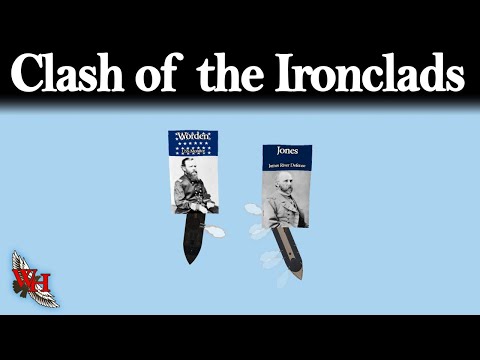American Civil War: Battle of Hampton Roads - "Clash of Ironclads"

When the Confederates secured Gosport Navy Yard in Portsmouth, Virginia - known today as Norfolk Naval Shipyard - on April 21st, 1861, they recognized that it provided them with the basic equipment to create an ironclad warship. Confederate Secretary of the Navy Stephen Russell Mallory realized that the South could not match the North’s shipbuilding capacity, so he advised the Confederate Congress that they instead focus their naval war effort on producing and utilizing ironclad warships instead. The ironclad warship was a recent and exciting new development in naval technology. The British Royal Navy had begun developing these new ships of war in early 1859, in the aftermath of the Crimean War with Russia. The ironclad was designed to resolve the vulnerability of traditional “wooden-clad” warships to explosive or incendiary shells. New advancements in naval and metal technologies thanks to the Industrial Revolution had finally allowed for such experiments to take place. A steam-propelled vessel would be covered
with iron or steel armor plates, protecting the outer hull of a ship from cannon balls and round shot, which would theoretically bounce off the iron or steel plating with minimum or no damage to the vessel itself. The first ironclad battleship, Gloire, was launched by the French Navy in November of 1859. However, it wouldn’t be until the American Civil War that these experimental warships would be tested in battle for the first time in naval military history against one another - at Hampton Roads, Virginia. To achieve his goal of producing ironclad warships for the Confederate Navy, Secretary of the Navy Mallory approved the conversion of the scuttled steam-screw frigate USS Merrimack into an ironclad. The frigate was raised, placed into dry dock and transformed into
a warship the likes of which had never been seen. The Merrimack was cut down to her berth deck, giving her a new length of 262 feet and 9 inches. The hull was topped by a 170-foot-long casemate consisting of twenty-four inches of oak and pine backing, sheathed with two layers of iron plate, two inches thick by six inches wide. The casemate sides were sloped at a thirty-six-degree angle to deflect shot, but the acute slope only allowed seven feet of headroom and a beam of thirty feet. The Confederate ironclad was armed with the finest possible heavy cannons. She would carry a broadside
battery of six 9-inch Dahlgrens and two 6.4-inch Brooke rifles. Two of the Dahlgrens smoothbores were hot-shot guns. A seven inch Brooke rifle rested on a pivot mount at each end of the casemate, where the structure was pierced by three gun ports. In addition to this armament, a 1,500-pound cast-iron ram was attached to the ironclad’s bow. The Confederates were in a rush to finish their warship; news of the construction of several Union ironclads meant that the South might lose its armored advantage if the vessel was not quickly put into action. The project encountered daily delays, particularly in
iron production, but the reconfigured ship finally was launched on February 17th, 1862, and commissioned into the Confederate States Navy as the CSS Virginia. She appeared to be powerful; however, there were numerous defects, including the re-use of the previously condemned engines, a draft too deep - twenty-two feet to be exact - and a poorly mounted ram. In February, 1862, Confederate Navy Flag Officer Franklin Buchanan is detailed as commander of the James River defenses with the Confederacy’s new ironclad as his flagship. Buchanan, a forty-six-year veteran of the U.S. Navy and the U.S. Naval Academy’s first superintendent, is a dynamic officer. Lieutenant John Randolph Eggleston, one of the Virginia’s officers wrote of Buchanan, saying that he was “A typical product of the old-time quarter deck.”
He was “as indomitably courageous as Nelson and as arbitrary.” Mallory expects great things of Flag Officer Buchanan and the Virginia. The navy secretary suggests that the ironclad should make a dashing cruise on “the Potomac as far as Washington”, stating, “its effect on the public mind would be important to our cause.” Such a
bold move could bring victory at a time when the Confederacy is reeling from defeats in Tennessee and the Carolina sounds. Mallory is convinced that “the opportunity and means for striking a blow for our Navy are now for the first time presented.” Mallory’s instructions are not lost on Flag Officer Buchanan. He selects Newport News Point as his target, but his hopes for a joint army-navy attack are dashed by the unwillingness of Major General John B. Magruder, commander of the Confederate Army of the Peninsula,
to cooperate. Undaunted, Buchanan still intends to take his ironclad into action as quickly as is feasible. A gale forces him to call off attacks on March 6th and 7th, as the Virginia needs calm waters in which to operate. On March 8th, 1862, the weather clears, and Buchanan prepares the ironclad for action. He hoists his flag officer’s red pennant over the CSS Virginia and orders the crew to cast off from the quay at Gosport Navy Yard. Workmen dash off the ironclad without
completing many minor details. The banks of the Elizabeth River throng with thousands of cheering citizens. The Confederate ironclad’s trial run down the Elizabeth River proves that the ironclad is as unmanageable as a “water-logged log”. The warship is slow
with a speed of five knots, and runs so close to the river bottom with her twenty-two foot draft that a towline from the CSS Beaufort is needed to help the huge ironclad round a bend in the river. As the ship passes Craney Island, Flag Officer Buchanan informs the crew, “Sailors in a few minutes you will have the long awaited opportunity to show your devotion to our cause…The Confederacy expects every man to do his duty, beat to quarters.” The ironclad drops her towline from the Beaufort and enters Hampton Roads at high tide. The entire Federal fleet goes into battle stations with the shout “that thing is a-comin at last sir.” The Virginia appears like “the roof of a very big barn belching forth smoke as from a chimney on fire.” It takes the huge vessel over one hour to reach Newport News Point. Buchanan had decided that his
first attack should be made against the two Union sailing warships stationed there, the fifty-two gun sailing frigate USS Congress and the twenty-four gun sailing frigate USS Cumberland. The Cumberland is his primary target, as Buchanan understands that she is armed with a seventy pounder rifle, the only weapon he thinks capable of damaging his ironclad. And so, the Battle of Hampton Roads begins when the CSS Virginia and her consorts, the gunboats CSS Raleigh and the CSS Beaufort, exchange fire with the Union forces at Newport News Point. The Beaufort fires the first Confederate shot of the day. The first shot from the Virginia’s forward seven inch Brooke rifle strikes the Cumberland’s starboard rail, injuring several Marines. Then, the Confederate vessel passes the Congress. The two warships trade salvos. Shot from the frigate bounces off the Confederate ironclad like “pebble-stones.” As if by
a miracle, no projectile enters into the wide-open ports. The Virginia replies and unleashes her broadside of four guns against the Union warship. Hot shot and shell ignites two fires on the hapless frigate, and the Congress appears critically damaged.
The Virginia does not stop to complete the destruction of the Congress, but continues on toward the USS Cumberland. The sloop keeps up her fire against the oncoming ironclad, but her shot “struck and glanced off, having no more effect than peas from a pop-gun.” The Confederate ship steams over the anti-torpedo obstructions surrounding the wooden vessel and rams the sloop of war in her starboard quarter. The Cumberland is mortally wounded from the attack; the ramming is only made worse by a simultaneous shot from the ironclad’s bow rifle, which kills ten men. The Union warship immediately begins to sink with the ironclad’s ram trapped within the sloop’s hull. As the weight of the sloop rests upon the ram, the Virginia’s engines refuse to reverse, and the Confederate ironclad begins to settle. Finally, the poorly mounted ram breaks off and frees the vessel. Ashton Ramsay
later noted, “Like a wasp we could sting but once leaving the sting in the wound.” The Virginia floats fifty yards apart from the Cumberland as the two ships continue to bombard each other. The sloop turns into a slaughterhouse, and the Cumberland’s death toll is 121. The ironclad also receives significant damage from her encounter with the Union ship. The Virginia’s smokestack is riddled; the damaged funnel causes the gun deck to fill with smoke, and the vessel’s speed is lessened. Three broadsides from the Cumberland shoot away the starboard anchor, starboard cutter, guard howitzers, stanchions and iron railings.
The wooden warship’s gunners aim at the ironclad’s gun ports, hoping to send solid shot inside the casemate. Two gun muzzles are shot off.; one is broken so short that at each subsequent discharge its port is set on fire. Finally, the Cumberland lurches forward and begins to go under as her acting commander, Lieutenant George U. Morris, shouts to the crew, “Give them a broadsides boys, as she goes.”
The Virginia, due to her deep draft and poor steering, is forced to steam up the James River to turn around. While this maneuver is being executed, Lieutenant John Taylor Wood strikes the Congress with several shells from the seven inch stern Brooke rifle. The ironclad also destroys two Union transports and captures another, all of which are anchored along a wharf. The warship then steams to within two hundred yards of the stranded USS Congress. The frigate’s stern is quickly demolished and the main deck is, according to one sailor, “literally wreaking with slaughter.” The armed tug, USS Zouave, is struck by several shells from the Virginia. When a shell hits
the Zouave’s rudderpost, the disabled vessel breaks off action and flees the scene. Lieutenant Joseph B. Smith, acting commander of the Congress, is struck by a shell fragment, which tears off a portion of his head and shoulder. The ship’s command evolves onto the shoulders of Lieutenant Austin Pendergrast, and he proceeds to surrender the ship. Flag Officer Buchanan orders two of his support vessels, the CSS Raleigh and CSS Beaufort, to remove the wounded, accept the ship’s surrender and then to complete her destruction. Brigadier General Joseph K. Mansfield, commander of Camp Butler at Newport News Point, orders
his men to open fire on the Confederates and forces them to back away from the Congress. Buchanan orders Lieutenant Robert D. Minor to row over to the frigate in the Virginia’s remaining cutter. A volley of musketry hits the boat, and Lieutenant Minor is seriously
wounded. The CSS Teaser, commanded by Lieutenant William Webb, picks up the survivors in a bold dash. Buchanan, standing atop the Virginia and enraged by the Union actions under a flag of truce, shoots at the Federal soldiers on the shore. They return fire, and he is badly wounded in the thigh. He is carried below, where he orders his executive officer, Lieutenant Catesby ap Roger Jones to “plug hot shot into her and don’t leave until she is afire.” Lieutenant Jones then assumes command of the Virginia. The Congress is soon burning from
stem to stern, and Jones steered his ironclad back into Hampton Roads. As the Virginia destroyed the two warships at Newport News Point, other Union vessels attempt to come to their support. The 43-gun screw frigate USS Roanoke, the 50-gun sailing frigate USS St. Lawrence, and the 44-gun steam frigate USS Minnesota all run aground and are stranded. While the Roanoke is pulled to safety by the tug USS Mystic, the other warships are shelled by the Virginia as she steams toward Sewell’s Point. Darkness and a receding tide compels Jones to moor his vessel; however, gunfire from the ironclad damages both Union frigates. As the spars and ropes of the Congress glitter against
the dark sky in dazzling lines of fire, Lieutenant Jones vows to destroy the Federal fleet the next day. When daylight arrives on Sunday, March 9th, 1862, the Minnesota, despite all efforts to float her, is still aground. There appears nothing that the warship can do but to wait for the Virginia’s arrival. The frigate’s
commander, Captain Gershom J. H. Van Brunt, is prepared to destroy his ship rather than allow it to be captured by the Confederates. The Virginia gets underway from her Sewell’s Point mooring at about 6:00 AM, accompanied by the Patrick Henry, Jamestown, and Teaser. Due to a heavy fog, the small fleet delays entering Hampton Roads until nearly 8:00 AM. Jones sees the Minnesota still stranded on the shoal as the Virginia closes within range.
Two shells from the Confederate ironclad strike the Union frigate, and the Confederates believe that they will quickly destroy the wooden warship. However, out from the side of the Minnesota comes, accordingly to the chief engineer of the Confederate ironclad, Ashton Ramsay, “a barrel-head afloat with a cheese box on top of it…and boldly confronted us.” It is the USS Monitor. The Union ironclad’s appearance in Hampton Roads the night before is a virtual miracle. While the Monitor is not designed to counter the threat of the Confederate ironclad, it is fortunate that the Union ironclad arrives in time to disrupt the Virginia’s destructive work. She was a completely new concept of naval design, created by Swedish-American inventor John Ericsson. While the Confederate ship is a brilliant adaptation of materials at
hand, the Union vessel is an engineering marvel, containing several patents obtained by Ericsson. The ironclad is 173 feet in length, weighs 776 tons, and has a beam of 41.5 feet. Her draft is eleven feet, with a freeboard of less than a foot, and she can make seven knots. The ironclad is virtually awash with the sea. All of the ship’s machinery, magazine, and
quarters are positioned below the waterline. The turret and pilothouse are the only features protruding from the deck. The Monitor’s most impressive feature is her steam-powered, rotating, circular turret mounting two 11-inch Dahlgren smoothbores. The turret is constructed of eight layers of one-inch-thick, curved, rolled plates. The gun ports are equipped with iron shutters. The turret has an interior diameter of twenty feet and a height of nine feet. A pilothouse is the only other main feature above the deck.
It is a rectangular box of iron, standing three feet high and made of nine- by twelve-inch iron bars. A one-inch observation slit is included below the upper tier of iron bars. Lieutenant John L. Worden was selected as the Monitor’s commander. Worden had served in the U. S. Navy since 1834, and had been a prisoner of the Confederates after conducting
a secret mission to Fort Pickens in Pensacola Bay, Florida. Recently exchanged, Worden accepted the command of the experimental warship and commented, “After a hasty examination of her [I was] induced to believe that she may prove a success. At all events, I am quite willing to be an agent in testing her capabilities.” Not all of her crew was as sure of the ironclad,
as Quartermaster Peter Truscott noted that “She was a little bit the strangest craft I had ever seen.” Seaman David R. Ellis made perhaps the most telling remark about the ship as she readied to leave New York, commenting, “She had not been pronounced seaworthy, and no one could safely judge of her fighting qualities.” On the afternoon of March 6th, 1862, the ship left New York under tow by the steam tug Seth Low. The Monitor encountered severe storms off the New Jersey coast and almost sank en
route to Hampton Roads. The Union ship opens fire at 8:45 AM on March 9th, and for the next four hours, the two ironclads pound each other mercilessly with shot and shell. The battle is fought mostly at a range of less than one hundred yards. Worden hopes that by firing his heavy shot, 168-pound spherical projectiles using fifteen pounds of power, from the ironclad’s 11-inch Dahlgrens, such pounding would loosen or break the Virginia’s iron plates. In turn, the Confederate warship is at a disadvantage. She has only explosive shells, hot shot and canister, specifically to use against wooden warships. Thus, Jones’s strategy is first to concentrate on the Minnesota and if necessary, to try to ram or board the Union ironclad. The Monitor’s small size and quickness frustrates the Confederates, who try to fire at their opponent’s gun ports; yet, they discover that the turret revolves too quickly. The Federals realize that their shot is having
no damaging effect upon the Confederate ship, as they are limited to using half powder charges, and the shot continues to bounce off the sloped, iron sides of the Virginia. There are several problems aboard the Monitor, despite her technological advantages. The port stoppers prove to be almost too heavy to operate, and only one gun can be fired at a time. Both ports are left open because it is the only way to enhance the gun crew’s vision, since the communication system between the pilothouse and turret fails to function. The turret’s rotating system also malfunctions due to water damage, which causes the mechanism to rust. Therefore, the turret can not be stopped with any precision. Eventually, the guns are discharged ‘on the fly’ as the turret turns past the target.
After almost two hours of combat, Worden takes his ship out of action to replenish ammunition in the turret. Jones takes immediate advantage and steams the Virginia toward the stranded frigate. The Confederate ironclad, leaking from the loss of her ram the day before, then runs aground. The Virginia, unable to deflect her guns to defend herself, is pounded then
for over an hour by the Union ship. Somehow, the old engines eventually respond to the need, and the Virginia manages to free herself. Jones then tries to ram his opponent. The Union ironclad is hit with a glancing blow which causes no damage to the Monitor. The impact causes another leak in the Confederate vessel’s bow. His opponent’s evasive action enables Jones to once again maneuver toward the Minnesota. Several shells are sent against the frigate, one of which strikes the tug Dragon. The Dragon’s boiler bursts, and
the tug, which had been alongside the Minnesota to tow that vessel to safety once freed from the shoal, sinks. Worden is able to steer his ship between the Confederate ironclad and the Union frigate. He now decides to ram his nemesis, seeking to strike the larger ironclad’s propeller to disable her. The ironclad misses her target because of a malfunctioning steering system. As the Union ship passes the stern of the Virginia. Lieutenant John T. Wood fires the stern seven inch Brooke rifle at the pilothouse. The shell strikes the observation slit just as Worden is peering out. The explosion creates
a flash of light and a cloud of smoke which blinds Worden. Lieutenant Worden’s ship is steered off onto a shoal by Quartermaster Peter Williams, who later receives the Congressional Medal of Honor for his actions. Worden is taken to his cabin for treatment. The ironclad appears out of action as the minutes tick by, while executive officer Samuel Dana Greene is summoned from the turret to Worden’s cabin to assume command of the Monitor. Meanwhile, Jones begins to move his ship toward the Minnesota; however, the pilots warn him that the tide is receding. Consequently, Jones heads his ship back into the Elizabeth River. Greene finally meets with Worden, and the ironclad’s captain
gives his executive officer orders to protect the Minnesota. When Greene takes his place in the damaged pilothouse, the Virginia is already steaming toward the Elizabeth River, and Greene chooses not to pursue the Confederate vessel. Even though both sides claim victory, the first battle between ironclad warships in naval military history ends in a draw. Neither ship is seriously damaged during the engagement. The Monitor has indeed won a tactical victory, as the Union ironclad has stopped the Confederates from destroying the Minnesota and the rest of the Union wooden warships in Hampton Roads. The strategic victor is the Virginia because her mere existence enables the Confederates to control Hampton Roads and the entrance to the James River, thereby defending the water approach to Norfolk and Richmond. The ironclad’s presence forces Union Major General George B. McClellan to alter his Peninsula Campaign just as he is beginning to move his
huge army to Fort Monroe on the tip of the Virginia Peninsula. McClellan’s delays on the Lower Peninsula will have serious implications on his campaign. Although a draw, the Battle of Hampton Roads makes international headlines as the first battle fought exclusively between ironclad warships in naval history. Indeed, all eyes
are watching the naval action on March 8th - 9th, 1862, and its affect on navies across the world would be profound for decades to come. No longer would major European nations produce massive wooden sailed warships with rows and decks of cannon; now, the ironclad was in style, and the “Age of Sail” would soon be replaced with iron and steel. A new era in naval warfare had begun.
2021-07-20 06:30


